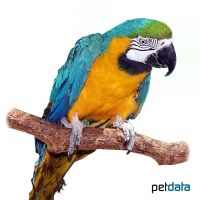Blue-and-yellow Macaw (Ara ararauna)
| Blue-and-yellow Macaw Ara ararauna | |
|---|---|
| Name | Blue-and-yellow Macaw |
| Name Lat. | Ara ararauna |
| Family | Parrots |
| Family lat. | Psittacidae |
| Order | Parrots |
| Order lat. | Psittaciformes |
| Origin | South America |
| Climate | Subtropical - tropical |
| Diet | Parrot seed, sprouts, veggies, fruits |
| Keeping | Pair, group |
| Care Level | Moderate |
| Reproduction | Cavity nest |
| Life Span | 50-60 years |
| Protection | CITES Appendix II; EC Annex B |
| Metric Units | |
| Size | 86 cm |
| Temperature | Room temperature |
| Housing | 400 x 200 x 200 cm |
| US Units | |
| Size | 34" |
| Temperature | Room temperature |
| Housing | 150" x 80" x 80" |
Distribution and habitat
The range of the Yellow-breasted Macaw extends from eastern Panama to Bolivia and Paraguay, where they live in savannahs with palm trees, open rainforests and in varzeas, which are forests that are periodically flooded.
Cage size
The minimum size of the aviary is 400 x 200 x 200 cm (L x W x H) for a pair. This size may not be undercut even in the case of justified single keeping. For an additional 2 birds, the floor space must be increased by 50%, provided that the birds are compatible with the species. The aviary must be placed in a bright, draft-free and quiet place and should have cross-wiring or netting. An aviary with 10 m² of floor space is recommended.
Maintenance
The floor must be covered with sand, shavings of untreated wood or similar material and cleaned once a week if possible. At least 2 perches made of wood or branches of different thickness and height are to be installed in such a way that the longest possible flight path is created. They need a bathing opportunity and should also be sprayed with water occasionally (e.g. sprinkler system). Rings, ropes, and natural branches that are not harmful to health should be offered for occupation. They should be kept at room temperature.
Diet
The species-specific food offer consists of mixed seeds, available in specialized trade as "Arafutter" in premium quality, which should also be offered in germinated form, depending on individual preference supplemented with green fodder (dandelion, chickweed, etc..), oil palm fruit, vegetables (peppers, carrots, etc.), fruit (apples, pears, etc.), fresh twigs, occasional animal protein (poultry bones, cat pellets), and sprouted seeds (wheat, corn) and egg food especially for raising young. Small seeds keep them more occupied and lead to better condition. As digestive aids they need grit, cuttlefish, vitamin lime, clay containing minerals and sandstones. Water must always be available in birdbaths or in stable, open containers. Food and water must be offered fresh daily, and the containers must be cleaned beforehand
A varied diet promotes health and prevents deficiency symptoms.
Reproduction and breeding
A reliable sex determination is only possible by endoscopy or better by genetic analysis (DNA).
They breed in nest boxes made of hardwood or better in thick-walled natural trunk cavities. Mulch or coarse sawdust is suitable as bedding. The clutch consists of 1-3 eggs, the incubation period is about 27 days. The breeding season is, biologically speaking, year-round. During the breeding season they may be kept only in pairs. Young birds should be raised so that they are species-specific.
Species protection
They must be identified in accordance with Appendix 6 of the Federal Species Protection Ordinance. The animal population must be reported in writing to the responsible authority immediately after the start of keeping. Your pet store will be happy to provide you with further information.
Species protection: WA Appendix II; EU Appendix B. The proof of purchase is the required proof of origin for the animal. Please keep it safe!
Important
In the case of outdoor aviaries, they also need a heated shelter of at least 2 m², which can be visited by the birds at any time. The temperature in the shelter must not fall below 10 °C and the furnishings must be the same as those used in cages
They may only be kept in pairs or in a group and not chained or on a hanger. Sufficient daylight or flicker-free artificial light (stroboscopic effect) corresponding to daylight shall be provided in rooms, including shelters. The lighting duration shall be 8-12 hours per day and the natural day-night rhythm shall be observed. Adequate indoor climate shall be provided. The health condition of the birds shall be checked daily.
Further literature can be found in your pet store.
References
Text: Othmar Sieberer; Image: petdata
Source: BMELV (1995): Tierschutzgutachten - Mindestanforderungen an die Haltung von Papageien; ARNDT (1997): Lexikon der Papageien, Arndt Verlag; GRUMMT & STREHLOW (2009): Zootierhaltung - Tiere in menschlicher Obhut: Vögel, Verlag Harri Deutsch
- Gemäß § 21 Abs. 5 Tierschutzgesetz idgF
